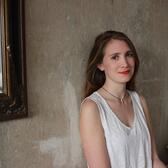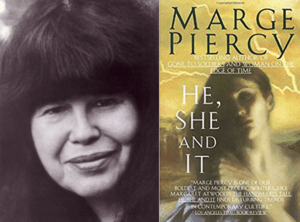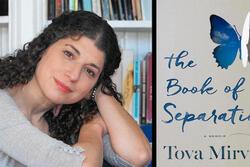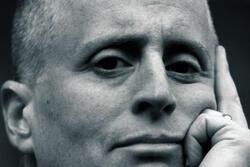An Interview with Marge Piercy
Like many Americans, we’ve been reflecting on dystopia at the Jewish Women’s Archive this year. When we were making our list for our 2017-2018 Book Club, we wanted to include a classic dystopian text that would inspire conversation about our current world and where it’s going. It seemed only natural to choose a book by Marge Piercy. Piercy is a Jewish feminist poet and novelist whose oeuvre covers women’s stories, politics, social justice, Jewish spirituality, and the increasingly dystopian world of the late twentieth and early twenty-first centuries. In her 1993 science fiction classic He, She, and It, which we chose for our November Book Club pick, Piercy tells the story of a near-future society in which corporations and environmental devastation have ravaged much of the world. Her heroine, Shira, leaves the corporation-controlled enclave where she’s spent her adulthood and returns to her Jewish hometown, which lies outside the corporation’s control. There, she befriends a cyborg who, in a parallel to the legend of the golem of Prague, has been engineered to protect the town from anti-Semitic outsiders. The story grapples with themes of gender, environmentalism, and the meaning of humanity.
We wanted Piercy’s perspective on dystopia in 2017, and so we talked to her about how she researched her book, which parts of it came true, what she thinks about artificial intelligence (AI), and how young activists can fight the good fight.
He, She, and It portrays a deeply dystopian world. How did you research and conceive of this world? Did you draw inspiration from the real world, or did you use your imagination? Or both?
I did an enormous amount of research on global warming, reading the relevant scientific papers that I could find. I did just as much research on artificial intelligence, including a consultation with the MIT AI lab, who were fans of the novel after it was published and who produced a glossary of Yiddish terms to help non-Jewish readers.
As for the political and corporate aspects, as one of the founders of the North American Congress on Latin America, I spent a couple of year doing power structure research. I was extrapolating from current trends – which have progressed today to the point where every cabinet post under Trump is run by an official from the corporations that the departments are supposed to regulate.
As for the Golem, I read just about everybody’s Golem stories, but I also researched the Maharal, as he really was. I read what I could about him and by him. Of course Tikva is an invention, as is Yod and Malkah, etc. I spent time in Prague twice and got to know it very well.
He, She, and It was published nearly three decades ago. From today's perspective, which dystopian elements of the book do you see coming true? Which seem unlikely, and which seem more likely than ever?
I believe just about all my predictions unfortunately are coming true. Global warming – climate change, whatever you choose to call it – is happening even faster than the best environmental science of the time I wrote the book expected.
The power of multinational corporations has grown immensely. Elections are, more than ever, a spectator sport. Corporate culture is something that can be reported on now. The Middle East remains a dangerous mess.
One of the most fascinating components of He, She, and It was the portrayal of a Jewish community sequestered in opposition to the dystopian, violent, capitalistic outside world. Do you see the Jews and the Jewish community as particularly well-suited to political and social resistance?If so, why?
Since I’m a Jew, and since I was using the golem myth, I thought a strong Jewish community and ethos was a necessary part of the overall plan of the novel. I had always wanted to write a golem story since my grandmother Hannah told me about the golem. I figured out how to do it finally when I linked AI with the golem. I also noticed the rise of anti-Semitism in the original golem story, which was something else that I incorporated into my book.
Reconstructionism, which is my branch of Judaism, is strongly concerned with the environment, so it was natural for me to incorporate that as well.
The plot of He, She, and It largely deals with artificial intelligence, both in the form of the golem of Prague and the story of Yod, an AI designed to protect the Jewish free town of Tikva. What is your opinion on AI as a technology? Do you see great utopian potential in the development of artificial intelligence, do you believe it to be dangerous, or are you somewhere in the middle?
Do you believe AI will ever be or could ever be viewed as human? Like all science, the use of AI depends on who gets to control it, who funds it, what it’s used for. I suspect that AI will have a growing place in our endless wars. I think AI is potentially useful and potentially dangerous. I think AI machines and robots will be approaching the ability to think for themselves and achieve consciousness faster than we imagine, and that raises the question of rights, duties, etc., and many concerns such as would it be murder to shoot down a machine with advanced AI? Would such advanced AI therefore be a slave? Should we free it then?
What advice would you give to young people who are currently concerned about the state of the world and who want to fight against environmental destruction and big business?
There are endless organizations that have sprung up since Trump entered office to fight many of his terrible decisions and appointments.There are also environmental organizations that have been around since the seventies. Join a group that appeals to you and work on the issue that most alarms or impinges on you. No one else can tell you what to join or what to work on. It has to be something that actually gets you excited, angry, and passionate, not something you think you should care about.







